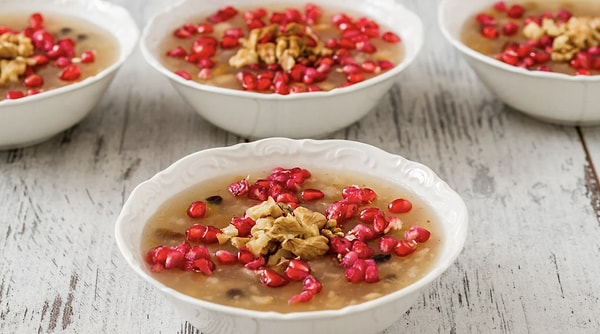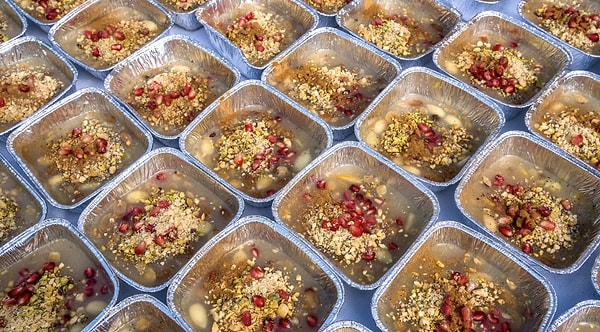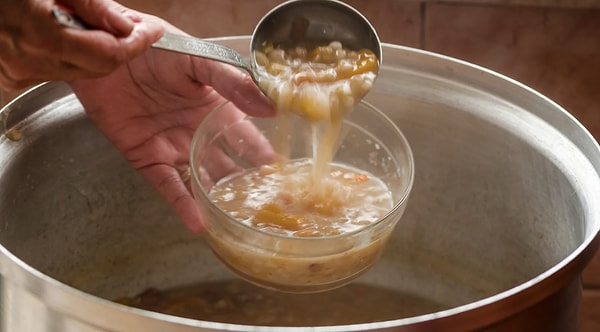How to Make the Famous Turkish Ashura: AKA Noah's Pudding
Muharram is the first month of the Islamic calendar (Hijri calendar). This month, which is accepted as the beginning of the calendar, is based on the Hijrah of the Prophet Muhammad. As of the 10th day of Muharram, the month of Ashura begins. During the month of Ashura, Ashura is cooked and distributed door-to-door until the end of the month of Muharram. Sharing this traditional dessert, which holds high spiritual significance, is believed to bring increased abundance to a household.
So, how to make Ashura? What is put into the Ashura? What are the ingredients of Ashura?
Here are the secrets and tricks of making a traditional Turkish Ashura!
What is Ashura?

Ashura derives from the Arabic word 'âşir' and means 'tenth'. This nomenclature refers to the tenth day of the month of Muharram according to the Hijri calendar. Ashura dessert, which is made on this special day, is widely cooked as a tradition in the Islamic world, especially in Turkey, Iran, Azerbaijan, Lebanon and some Balkan countries. Turkey has a deep-rooted history both religiously and culturally.
Ashura is a multi-component dessert that usually contains wheat, chickpeas, beans, dried fruits and various nuts. The fact that no animal products are used makes it universally suitable for many beliefs and diets.
History of Ashura

The origin of Ashura is related to many beliefs and communities both before and after Islam. In this respect, it can be considered not only a religion but also a common cultural heritage of humanity.
Noah's Flood and the Birth of Ashura
One of the most widespread rumours says that Ashura dates back to the time of Noah. According to the legend, when the Prophet Noah's ship survived the flood and settled on Mount Cudi, a meal was cooked with the last provisions they had. This dish is considered to be the first version of the dessert we know today as Ashura. This story is similar in both Islamic sources and some Christian narratives.
The Month of Muharram and the Day of Ashura in Islam
The day of Ashura is associated not only with Noah's Flood but also with many important events in Islamic history. According to some narrations, this day is said to be the day when Prophet Moses was saved from Pharaoh, the day when Prophet Jonah came out of the belly of the fish, and the day when Prophet Jesus was born or ascended into heaven. However, especially for Shiite Muslims, Ashura Day is a day of mourning due to the Karbala Incident. The martyrdom of Prophet Muhammad's grandson, Prophet Hussein, in Karbala makes this day meaningful with sadness and mourning. In this respect, Ashura has become a symbol of joy for some societies and a symbol of deep sorrow for others.
Cultural and Social Importance of Ashura

Ashura has been kept alive for centuries not only as a religious worship or ritual but also as a means of social sharing. In Turkey, especially from the 10th day of the month of Muharram for a few weeks, many houses in Turkey cook Ashura and distribute it to neighbours, relatives and those in need. This tradition is an important part of neighbourhood culture.
The distribution of Ashura is also an expression of social peace, the coming together of differences and solidarity. The combination of dozens of ingredients boiled together, different tastes and textures in a single flavour can also be read as a social metaphor.
Rituals and Beliefs of Ashura Day

There are also many beliefs and traditions about the day of Ashura that circulate among the people. For example;
It is believed that fasting on that day is virtuous.
It is believed that to have abundance in the house, it is absolutely necessary to cook Ashura.
It is believed that the houses that distribute Ashura will be peaceful and prosperous throughout the year.
In some regions, beliefs have developed that salt or sugar should not be added to the ashura.
Although such beliefs vary from region to region, they are based on a kind of 'charity' and social solidarity.
Classic and Delicious Ashura Ingredients

Between 7 and 41 kinds of ingredients can be put into the Ashura. This number may vary from region to region and may also be shaped according to personal taste. Wheat, sugar, cinnamon, clove juice, chickpeas, dried beans, dried fruits, dried fruits, dried nuts and pomegranate used for decoration are among the indispensable ingredients of Ashura, which usually contains 12 to 20 different ingredients. Orange peel can also be added to the recipe according to desire.
Ingredients Used in Making Ashura:
3 cups of wheat
1 cup of dried beans
1 cup of chickpeas
1 cup of dried apricots
1 cup of raisins
1 cup hazelnuts
3 litres of water (for boiling the wheat)
4 cups of granulated sugar
4 litres of hot water (to be used when necessary to adjust the consistency)
4,5 cloves
A flick of salt
Ingredients put on top of the Ashura:
100 grams of walnuts
25 grams of hazelnuts
25 grams of currants
Cinnamon
Sesame
Pomegranate (optional)
Each ingredient you choose enriches both the flavour and the appearance of the dessert. Pomegranate, in particular, is a traditional topping and gives the dessert a pleasant sour flavour.
Traditional and Delicious Ashura Recipe

The process of making Ashura starts the night before. Wheat, chickpeas and beans are soaked in advance. The next day, these ingredients are boiled separately until they are slightly softened. (The point to be considered here is that the ingredients should not disperse too much and should be soft enough.)
Combination of all flavours:
1. After the boiling water of the wheat is drained, some water is added to the pot and cooked for about 50 minutes.
2. After this time, add the previously boiled chickpeas and beans, chopped dried apricots and raisins and boil for another 15 minutes.
3. Then add sugar, salt, hazelnuts and cloves and cook the mixture for another 15 minutes. You can wrap the cloves in a clean cheesecloth and throw them into the pot in order to remove them easily after cooking.
4. It may be necessary to add hot water from time to time in order to adjust the consistency of the asura. Therefore, it is important to have boiling water with you during cooking.
5. When the asura reaches its consistency, divide it into bowls. Garnish with hazelnuts, walnuts, pomegranate, cinnamon and currants.
If you wish, you can also add dried mulberries, sesame seeds and figs on top of the Ashura to enhance its flavour. If you have these ingredients in your home, make use of them to enrich your soup.
What are the Tricks of Making Ashura?

There are some important points to be considered in the production of a traditional flavour. From the pot you choose to the ingredients you will use, every detail plays a decisive role in the result. Here are the main points you should pay attention to while making Ashura:
Pot Selection: The size of the pot you will use in making Ashura is extremely important. A wide and deep pot facilitates the cooking process and allows the ingredients to mix without overflowing.
Ingredient Quality: The freshness of the ingredients directly affects the flavour quality of the asura. For this reason, you should prefer fresh products as much as possible.
Preparation of Pulses: Pulses such as chickpeas, beans and halves should be soaked the night before and softened well. This stage directly affects the consistency of the soup. If these pulses are not softened enough, they cannot harmonise with the other ingredients.
Cooking Time: Ashura cooks in approximately 2 hours. However, to understand whether it is fully cooked or not, it is necessary to pay attention to its consistency and colour. An appearance with a dense consistency means that your soup is ready to serve.
Keşfet ile ziyaret ettiğin tüm kategorileri tek akışta gör!

Send Comment